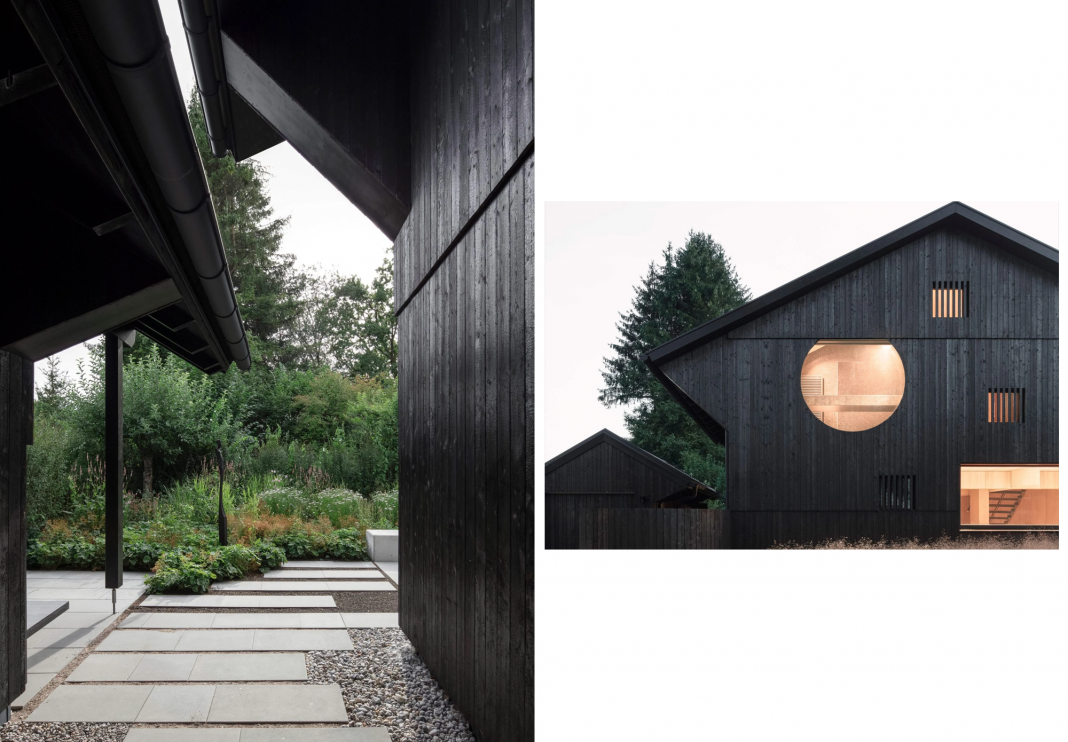In the quiet town of Söcking near Starnberg, Germany, local architecture studio Buero Wagner has reimagined suburban density and family living. Their latest project, Houses with One Pillar, features two conjoined homes—designed for a father and his son’s family—defined by charred timber exteriors and sculptural exposed-concrete interiors.
A vision for suburban densification
Set on a site that previously held a single residence, Houses with One Pillar explores how increased housing density can be achieved without compromising the character of a suburban neighbourhood. The project takes inspiration from Vision Starnberg 2025, a now-shelved urban initiative that sought to address housing demand through intelligent densification.
While the original urban plan was never realised, Buero Wagner used the concept as a starting point. “The design aims to redefine suburban living by demonstrating how high-quality, socially connected housing can be achieved within existing settlement structures,” said founder Fabian Wagner. With this ethos, the studio crafted two interlinked dwellings that share both architectural language and community spirit.
A mirrored form with distinct lives

The homes are conceived as architectural twins, nearly mirroring one another in form and layout. Their pitched roofs and gabled silhouettes blend harmoniously with surrounding houses, maintaining visual continuity within the neighbourhood. Externally, both structures are wrapped in dark, charred timber—a nod to traditional construction techniques, as well as a contemporary gesture that enhances material durability.
Despite their identical shells, each house is tailored for its respective inhabitants—an intergenerational arrangement where proximity fosters connection without sacrificing privacy. A pair of connected garages physically joins the two residences, while a shared garden surrounds them, subtly encouraging communal interaction between the families and their neighbours.
The pillar at the heart of the home
The name Houses with One Pillar originates from a defining interior gesture: a single concrete column that anchors the open-plan ground floor of each home. This minimalist structural strategy allowed Buero Wagner to create fluid and spacious living areas, free from excess supports or internal walls.

The floor gently steps down to differentiate zones—kitchen, dining, and living—while maintaining a sense of openness. A wooden core contains the entry, guest toilet, and kitchen storage, offering warmth and contrast to the otherwise concrete surroundings. In a striking detail, the kitchen island is cast directly onto the central pillar, seamlessly merging form and function into a unified spatial element.
A tactile interior of concrete and wood

The interiors are a study in material honesty and spatial discipline. Exposed concrete ceilings and walls have been sandblasted to soften their texture, revealing the grain of the formwork and lending a tactile quality to the surfaces. On the ground floor, concrete continues underfoot, enhancing thermal mass and visual continuity. In contrast, the upper levels introduce wooden flooring for warmth and acoustic comfort.
Movement through the space is choreographed by a narrow black-steel staircase, which rises to the first floor, leading to bedrooms and workspaces. Below, a full basement level provides ample storage and utility zones—essential for the functional demands of family life, yet discreetly tucked away.
Architectural clarity and future-forward thinking

For Buero Wagner, the success of Houses with One Pillar lies not only in its architectural clarity but also in its broader social proposition. By transforming a single-family lot into a shared, multi-generational dwelling without altering the suburban fabric, the project becomes a potential model for future densification efforts across similar towns.
“The project combines architectural clarity, efficient use of space, and material honesty to create a cohesive and sustainable living environment,” explained Wagner. The use of raw, unadorned materials paired with thoughtful spatial strategies results in homes that feel both contemporary and timeless.
A growing body of minimalist work
Founded in 2016, Munich-based Buero Wagner has consistently explored the intersection of craftsmanship, minimalism, and spatial innovation. Their portfolio includes a striking black-timber pavilion for the German Academy in Rome and a raw industrial office extension in Munich.

With Houses with One Pillar, the studio continues its trajectory, using architecture as a means to challenge suburban norms, foster social cohesion, and experiment with expressive material language. It is a quiet but powerful statement on how architecture can bridge generations—physically, emotionally, and spatially—without making a spectacle of itself.



